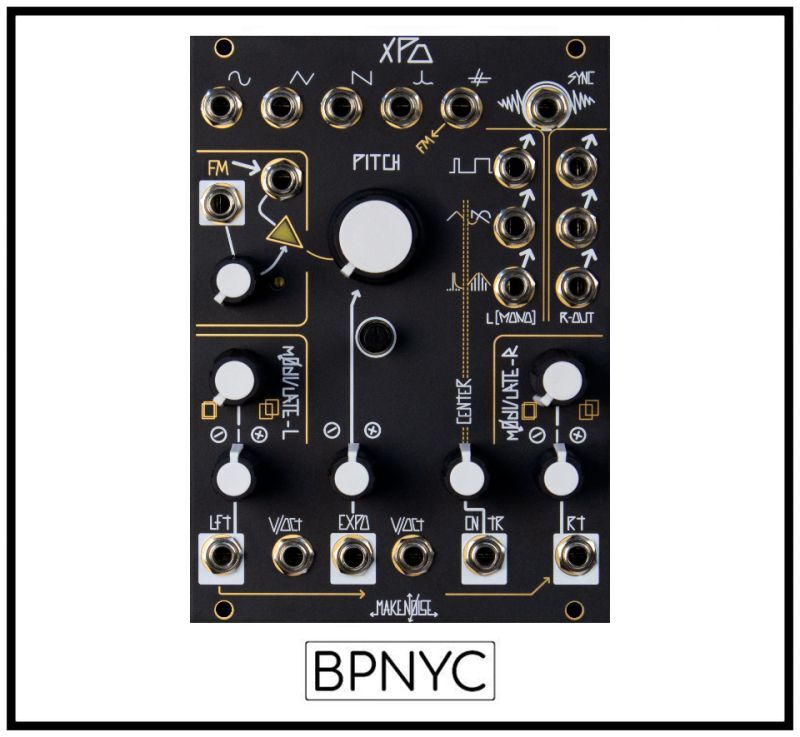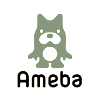商品詳細
Make Noise XPO 次回入荷分
販売価格: 61,006円
[通常販売価格: 64,900円]
重さ: 1lb
- Tweet
商品詳細
The XPO or Stereo Prismatic Oscillator music synthesizer module is a Voltage Controlled Analog Oscillator designed for generating Sine waves, Triangle waves, Sawtooth and Spike waves, Sub-Octaves, Stereo Timbre Modulations (including Pulse Width Modulation and Wavefolding), Oscillator SYNC, Linear FM and more in the analog domain.
The XPO is designed to be the Stereo VCO complement to our Stereo Filter, the QPAS. The two modules share the core idea of complex circuits being controlled in multiple dimensions in the stereo field by a few powerful parameters. The Stereo Prismatic Oscillator also makes a particularly useful patch buddy for the STO, Mimeophon, and X-PAN.
features
Stereo Analog VCO with eleven simultaneous outputs (five mono outs and three stereo pairs)
Modulate Timbre via Stereo Pulse-Width Modulation, Stereo Vari-Timbre, and Stereo Wavefolding
Sine, Triangle, Sawtooth, Spike, and SUB mono outs
Unique Mono versions of all Stereo Waveforms via Left output normalizations
Modulate Left and Right channels together or separately thanks to normalization and attenuverters
Center parameter adds additional timbre control to both sides of Vari-Timbre and Wavefolded outputs
Linear FM Bus features voltage-control over FM depth and a normalization of SUB to FM input for easy GROWL
Hard SYNC circuit
Two 1v/oct inputs for transposition, melody stacking, or richest FM
Expo FM input with attenuverter
Designed to pair well with QPAS, Mimeophon, and X-PAN
specifications
Width: 18hp
Max Depth
(incl. power cable):coming soon
Power:
140mA @ +12V
132mA @ -12V
The Story of the XPO by Tony Rolando
I was lying awake in bed at 3 am thinking about music and synthesizers, on this early morning specifically, the voice panning of the OB8. So simple, so effective. A bank of 8 analog pan-pots is tucked into the side of the instrument to let the musician choose the exact placement of each voice in the stereo field. As you play the instrument, notes may dance around your head. This led me to think about how Oberheim and most other synthesizer designers through the 70s and early 80s primarily used Pulse Width Modulation for waveform animation. Don Buchla's wavefolding techniques had not caught on. PWM has been more or less the same for decades and there is not a whole lot of difference between PWM in one instrument to another. Some allow you to modulate further than others. A few even allow you to go all the way to 0% or 100% Width. PWM was usually generated from a Saw or Triangle core, and while I tend to prefer PWM generated from a Tri-Core, the difference is subtle. The bigger difference is the filter that follows. PWM has a way of tickling the resonance of a filter that can really make the sound come alive.
This led me to think about Stereo filtering. How could a synth sound more stereo? At Make Noise we have voice panning with the XPAN, stereo filtering with the QPAS, and stereo echo verb with the Mimeophon. Surely, this was enough stereo modulation.
Then it occurred to me, why couldn't PWM be stereo? It would be very effective at creating a stereo image since the amplitude of both Left and Right would be almost identical, while still offering dramatic stereo timbral shifts. I thought to myself, surely somebody has done Stereo PWM already. I needed to research this idea. So I wrote about it in the notepad I keep on the nightstand and I eventually fell back asleep.
I woke up the next day and I immediately saw the note, I tried to read it...
It was very hard to make out what I had written, but it seemed like it said:
"The planets of our solar system, incinerating. Like flaming globes, Sigmund." After a cup of coffee, I was finally able to make out what the note actually said.
"What could make the QPAS and Mimeophon sound even more stereo? Stereo Pulse Width Modulation?"
I spent the day searching for Stereo Pulse Width Modulation. I did not limit myself to modules. I read manuals of synthesizers from the 70's into current times. I found nothing of the sort. Perhaps there was a reason it did not yet exist? Perhaps Stereo Timbral Modulation prior to a Stereo Filter and Stereo DSP was just too much Stereo.
It seemed to be worth at least exploring so I built up a circuit to test it. The sound was OK, it was definitely stereo, but it was not incredible. I patched it into the QPAS. It deepened the stereophonic effect of QPAS in a meaningful way. The two pairs of filter cores were having their resonant peaks excited independently. I felt very connected to the modulation of the stereo field, too. All of this came without having to worry about tuning between two oscillators.
So I looked to our STO for further inspiration. I tried the STO Variable Shape circuit in stereo and it sounded great, but it could get pretty unbalanced from left to right as it was modulated. I re-designed the circuit to compress the sound in order to get it to be more balanced. I called the new circuit Stereo Vari-Timbre.
I tried stereo sawtooth animation and it was less effective. The sound was very balanced (like PWM) but it was not as dramatic and powerful. Also, It took a great deal of analog circuitry to create the effect. I figured if I was going to put that many parts on the design, I might as well look to the DPO for inspiration. Stereo Wavefolding! It was wonderful, especially when patched into the QPAS.
The Stereo VCO was a new or at least uncommon concept, why not tie it to an existing framework to ease the learning curve. I looked to the QPAS for conceptualizing the user interface. I figured that if somebody could learn the QPAS Stereo VCF, they could use similar techniques for the modulation of a Stereo VCO. The QPAS form factor of dedicated Left and Right modulation parameters normalled from left to right. Pitch control in the middle. Stereo outputs along the right side, so as to be in line with the QPAS stereo inputs. Then there was the QPAS "Q" parameter.
I had wanted the XPO to have a center parameter. Something that modified both sides of the sound simultaneously, just as the "Q" parameter does on the QPAS. What is nice about the Q parameter is that it affects ALL 4 cores in the QPAS. The center parameter needed to vary the mono waveshape in a way that would make the stereo waveshaping circuits that follow it even more interesting.
This was easy with the Stereo Wavefolder as I already had a unique circuit to do this in the DPO. The Shape parameter from DPO was excellent as a center parameter.
For the Stereo Vari-Timbre, I looked to the STO, but there was nothing that would work as a center parameter. So I looked beyond the STO to the modules that inspired and informed it. The early Buchla Oscillators 158 and 258 where they allow for crossfading between Sine and Saw. This is such a simple circuit, but it sounds so wonderful and it is extremely useful.
The Stereo PWM channel which sparked this whole module idea did not comply with the Center parameter. I struggled for months trying to figure out some way I could modulate the PWM circuit through the Center. Everything I tried was either too dramatic, making PWM no longer PWM, or easier and better achieved with commonly existing modules. I finally convinced myself that having one set of outputs that is not influenced by the Center parameter could be functionally advantageous. You could Audio Rate Modulate (FM) Center and get more harmonically rich Folds all while PWM remained clear of these harmonics, for example.
With the stereo elements designed I still had plenty of space left. I put as many mono waveforms as I could fit. Since I had to create many waveshapes to do everything I wanted to do with the Stereo outs, I had many to choose from. I feel having many, simultaneously available waveform outputs exponentially increases the functionality of the module. Covering the standards, SINE, TRI, SAW... I did a more traditional SAW as opposed to the weird wiggly SAW from the DPO. I figured you could get something like this from the Vari-Timbre outputs. Instead of the Square, I added Spike, since it is a less common wave shape and also works great with a BP filter as found in QPAS. Once again looking to the STO, I put a variation of the SUB.
The XPO is designed to be the Stereo VCO complement to our Stereo Filter, the QPAS. The two modules share the core idea of complex circuits being controlled in multiple dimensions in the stereo field by a few powerful parameters. The Stereo Prismatic Oscillator also makes a particularly useful patch buddy for the STO, Mimeophon, and X-PAN.
features
Stereo Analog VCO with eleven simultaneous outputs (five mono outs and three stereo pairs)
Modulate Timbre via Stereo Pulse-Width Modulation, Stereo Vari-Timbre, and Stereo Wavefolding
Sine, Triangle, Sawtooth, Spike, and SUB mono outs
Unique Mono versions of all Stereo Waveforms via Left output normalizations
Modulate Left and Right channels together or separately thanks to normalization and attenuverters
Center parameter adds additional timbre control to both sides of Vari-Timbre and Wavefolded outputs
Linear FM Bus features voltage-control over FM depth and a normalization of SUB to FM input for easy GROWL
Hard SYNC circuit
Two 1v/oct inputs for transposition, melody stacking, or richest FM
Expo FM input with attenuverter
Designed to pair well with QPAS, Mimeophon, and X-PAN
specifications
Width: 18hp
Max Depth
(incl. power cable):coming soon
Power:
140mA @ +12V
132mA @ -12V
The Story of the XPO by Tony Rolando
I was lying awake in bed at 3 am thinking about music and synthesizers, on this early morning specifically, the voice panning of the OB8. So simple, so effective. A bank of 8 analog pan-pots is tucked into the side of the instrument to let the musician choose the exact placement of each voice in the stereo field. As you play the instrument, notes may dance around your head. This led me to think about how Oberheim and most other synthesizer designers through the 70s and early 80s primarily used Pulse Width Modulation for waveform animation. Don Buchla's wavefolding techniques had not caught on. PWM has been more or less the same for decades and there is not a whole lot of difference between PWM in one instrument to another. Some allow you to modulate further than others. A few even allow you to go all the way to 0% or 100% Width. PWM was usually generated from a Saw or Triangle core, and while I tend to prefer PWM generated from a Tri-Core, the difference is subtle. The bigger difference is the filter that follows. PWM has a way of tickling the resonance of a filter that can really make the sound come alive.
This led me to think about Stereo filtering. How could a synth sound more stereo? At Make Noise we have voice panning with the XPAN, stereo filtering with the QPAS, and stereo echo verb with the Mimeophon. Surely, this was enough stereo modulation.
Then it occurred to me, why couldn't PWM be stereo? It would be very effective at creating a stereo image since the amplitude of both Left and Right would be almost identical, while still offering dramatic stereo timbral shifts. I thought to myself, surely somebody has done Stereo PWM already. I needed to research this idea. So I wrote about it in the notepad I keep on the nightstand and I eventually fell back asleep.
I woke up the next day and I immediately saw the note, I tried to read it...
It was very hard to make out what I had written, but it seemed like it said:
"The planets of our solar system, incinerating. Like flaming globes, Sigmund." After a cup of coffee, I was finally able to make out what the note actually said.
"What could make the QPAS and Mimeophon sound even more stereo? Stereo Pulse Width Modulation?"
I spent the day searching for Stereo Pulse Width Modulation. I did not limit myself to modules. I read manuals of synthesizers from the 70's into current times. I found nothing of the sort. Perhaps there was a reason it did not yet exist? Perhaps Stereo Timbral Modulation prior to a Stereo Filter and Stereo DSP was just too much Stereo.
It seemed to be worth at least exploring so I built up a circuit to test it. The sound was OK, it was definitely stereo, but it was not incredible. I patched it into the QPAS. It deepened the stereophonic effect of QPAS in a meaningful way. The two pairs of filter cores were having their resonant peaks excited independently. I felt very connected to the modulation of the stereo field, too. All of this came without having to worry about tuning between two oscillators.
So I looked to our STO for further inspiration. I tried the STO Variable Shape circuit in stereo and it sounded great, but it could get pretty unbalanced from left to right as it was modulated. I re-designed the circuit to compress the sound in order to get it to be more balanced. I called the new circuit Stereo Vari-Timbre.
I tried stereo sawtooth animation and it was less effective. The sound was very balanced (like PWM) but it was not as dramatic and powerful. Also, It took a great deal of analog circuitry to create the effect. I figured if I was going to put that many parts on the design, I might as well look to the DPO for inspiration. Stereo Wavefolding! It was wonderful, especially when patched into the QPAS.
The Stereo VCO was a new or at least uncommon concept, why not tie it to an existing framework to ease the learning curve. I looked to the QPAS for conceptualizing the user interface. I figured that if somebody could learn the QPAS Stereo VCF, they could use similar techniques for the modulation of a Stereo VCO. The QPAS form factor of dedicated Left and Right modulation parameters normalled from left to right. Pitch control in the middle. Stereo outputs along the right side, so as to be in line with the QPAS stereo inputs. Then there was the QPAS "Q" parameter.
I had wanted the XPO to have a center parameter. Something that modified both sides of the sound simultaneously, just as the "Q" parameter does on the QPAS. What is nice about the Q parameter is that it affects ALL 4 cores in the QPAS. The center parameter needed to vary the mono waveshape in a way that would make the stereo waveshaping circuits that follow it even more interesting.
This was easy with the Stereo Wavefolder as I already had a unique circuit to do this in the DPO. The Shape parameter from DPO was excellent as a center parameter.
For the Stereo Vari-Timbre, I looked to the STO, but there was nothing that would work as a center parameter. So I looked beyond the STO to the modules that inspired and informed it. The early Buchla Oscillators 158 and 258 where they allow for crossfading between Sine and Saw. This is such a simple circuit, but it sounds so wonderful and it is extremely useful.
The Stereo PWM channel which sparked this whole module idea did not comply with the Center parameter. I struggled for months trying to figure out some way I could modulate the PWM circuit through the Center. Everything I tried was either too dramatic, making PWM no longer PWM, or easier and better achieved with commonly existing modules. I finally convinced myself that having one set of outputs that is not influenced by the Center parameter could be functionally advantageous. You could Audio Rate Modulate (FM) Center and get more harmonically rich Folds all while PWM remained clear of these harmonics, for example.
With the stereo elements designed I still had plenty of space left. I put as many mono waveforms as I could fit. Since I had to create many waveshapes to do everything I wanted to do with the Stereo outs, I had many to choose from. I feel having many, simultaneously available waveform outputs exponentially increases the functionality of the module. Covering the standards, SINE, TRI, SAW... I did a more traditional SAW as opposed to the weird wiggly SAW from the DPO. I figured you could get something like this from the Vari-Timbre outputs. Instead of the Square, I added Spike, since it is a less common wave shape and also works great with a BP filter as found in QPAS. Once again looking to the STO, I put a variation of the SUB.
*** お問い合わせ&予約受付中 ***
当店で扱っている各商品は大量生産ではありません。 メーカーにも在庫に限りがあります...
確実に欲しい商品に関しては早めに予約/在庫確認する事をおすすめします...
尚、お取り寄せをしなければいけない場合の納期は大抵3~5週間位と思っていただければ幸いです。





